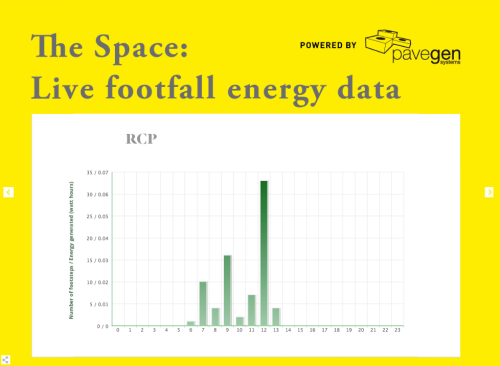This is the fourth and final example of compelling initiatives that we feel are using #TechforGood – part of our video campaign (watch here) where we called for people to nominate inspiring initiatives of tech being used for wider social impact.
 Laurence Kemball-Cook (@LaurenceKC) is the founder and CEO of Pavegen as well as an innovation fellow at Loughborough University and a member of the Institution of Mechanical Engineers. His truly disruptive invention, a connected pavement slab which generates energy and data from footsteps, is shaking up the world of sustainability.
Laurence Kemball-Cook (@LaurenceKC) is the founder and CEO of Pavegen as well as an innovation fellow at Loughborough University and a member of the Institution of Mechanical Engineers. His truly disruptive invention, a connected pavement slab which generates energy and data from footsteps, is shaking up the world of sustainability.
Florence Broderick sat down with Laurence to find out more about the Pavegen story and his vision for a more connected and sustainable world.
How did Pavegen come about?
Back in 2009 I was working at one of Europe’s largest energy companies as a design engineer when I was asked to develop a streetlight powered by solar and wind. I failed to deliver on the project and as an engineer I was frustrated so I left the business wanting to find new sustainable energy solutions. The concept of Pavegen came about in 2009 whilst researching kinetic, off-grid energy solutions at Loughborough University. We took it to a design show against 1,000 other students and became an overnight viral hit.
From then on I was receiving hundreds of phone calls a day which is what motivated me to commercialise the product even though the credit crunch and a lack of equity funding would make it tough. Friends who worked in factories worked through the night to make components for us and we even broke into building sites to install the product in their grounds so that we could put it on our website to get traction and close deals. We soon raised investment and started generating revenue.
What makes Pavegen a special #TechforGood project?
The great thing is that we don’t just do energy, we do big data too. Each footstep on our pavement slabs generates energy which we store in batteries and later use in an off grid power source which can power streetlights or even transport. This data also gives retailers and developers a granular look at how people move through cities. There will be a total of 8 billion connected devices by 2018 and this Internet of Things will demand significant and innovative power sources, this is where we come in.

A real-time chart showing the number of footsteps at the RCP office.
What is your vision for smart cities? Where does Pavegen fit in?
Smart cities are going to need seamless integration if they are going to be a success. The pavement needs to talk to the road, the road needs to talk to buildings, it all needs to be seamlessly connected. Decentralised power networks are fundamental in this happening and we know we can make a tangible impact on energy consumption because sustainability and smart cities are about looking after the planet for our future generations on a micro level.
How are you scaling up Pavegen? Have you had any particular successes?
We’re already working in 15 countries across the world including Japan, Korea, Australia and the USA. We were also chuffed to win the Energy and Carbon Management Long-term Payback Award at the 2degrees Sustainability Awards at Wembley Stadium last week coming up ahead of the likes of Diageo and Honeywell. In terms of big projects, we have an important installation kicking off this week at one of the world’s most important international airports as well as another starting later this month in Rio de Janeiro in Brazil.
What inspired you to become an inventor and entrepreneur?
I always remember reading about some research by George Land. Basically he distributed a creativity test used by NASA to select innovative engineers and scientists among 1,600 5 year-olds. He re-tested the same children at 10 years of age, and again at 15 years of age. 98% of 5 year-olds, 30% of 10 year-olds, 12% of 15 year-olds and only 2% of adults were creative. I agree with the finding that non-creative behaviour is learned and I believe that regulation and formal teaching aren’t helping entrepreneurship. I never liked the system and I fought against it. Education can starve us of creative drive but I had no fear when I set out to make this a success.









